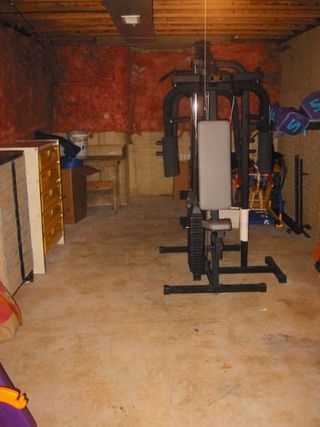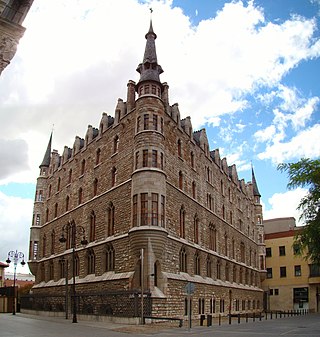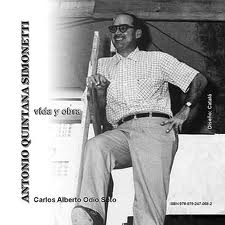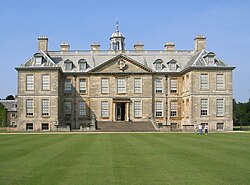
Casa Batlló is a building in the center of Barcelona, Spain. It was designed by Antoni Gaudí, and is considered one of his masterpieces. A remodel of a previously built house, it was redesigned in 1904 by Gaudí and has been refurbished several times after that. Gaudí's assistants Domènec Sugrañes i Gras, Josep Canaleta and Joan Rubió also contributed to the renovation project.

The Basílica i Temple Expiatori de la Sagrada Família, otherwise known as Sagrada Família, is a church under construction in the Eixample district of Barcelona, Catalonia, Spain. It is the largest unfinished Catholic church in the world. Designed by Catalan architect Antoni Gaudí (1852–1926), his work on Sagrada Família is part of a UNESCO World Heritage Site. On 7 November 2010, Pope Benedict XVI consecrated the church and proclaimed it a minor basilica.

An apartment, flat, or unit is a self-contained housing unit that occupies part of a building, generally on a single storey. There are many names for these overall buildings. The housing tenure of apartments also varies considerably, from large-scale public housing, to owner occupancy within what is legally a condominium, to tenants renting from a private landlord.

A basement or cellar is one or more floors of a building that are completely or partly below the ground floor. Especially in residential buildings, it often is used as a utility space for a building, where such items as the furnace, water heater, breaker panel or fuse box, car park, and air-conditioning system are located; so also are amenities such as the electrical system and cable television distribution point. In cities with high property prices, such as London, basements are often fitted out to a high standard and used as living space.

The Portico Library, The Portico or Portico Library and Gallery on Mosley Street in Manchester, England, is an independent subscription library designed in the Greek Revival style by Thomas Harrison of Chester and built between 1802 and 1806. It is recorded in the National Heritage List for England as a Grade II* listed building, having been designated on 25 February 1952, and has been described as "the most refined little building in Manchester".

The Brisbane Showgrounds is a multi-purpose venue located in Bowen Hills, Brisbane. Established in 1875, it hosts more than 250 events each year, the largest being the Royal Queensland Show (Ekka).

Customs House is a heritage-listed customs house at 427 Queen Street, Brisbane CBD, Brisbane, Queensland, Australia. It was designed by Charles H McLay and built from 1886 to 1889 at a cost of £38,346 by John Petrie & Son. It was originally used for the collection of customs duty and was opened in 1889, when Queensland was a British colony, replacing the original Customs House located at Petrie Bight. It was added to the Queensland Heritage Register on 7 February 2005.

The Church of Colònia Güell is an unfinished work by Antoni Gaudí. It was built as a place of worship for the people on a hillside in a manufacturing area in Santa Coloma de Cervelló, near Barcelona. Colònia Güell was the brainchild of Count Eusebi de Güell; who enlisted the help of architect Antoni Gaudí in 1898. However, work was not started until 1908, 10 years after commission. The plan for the building consisted of constructing two naves, an upper and a lower, two towers, and one forty-meter-high central dome. In 1914, the Güell family halted construction due to the death of Count Güell. At the time, the lower nave was almost complete so between the years of 1915 and 1917, it was completed and readied for use.

Servants' quarters are those parts of a building, traditionally in a private house, which contain the domestic offices and staff accommodation. From the late 17th century until the early 20th century, they were a common feature in many large houses. Sometimes they are an integral part of a smaller house—in the basements and attics, especially in a town house, while in larger houses they are often a purpose-built adjacent wing or block. In architectural descriptions and guidebooks of stately homes, the servants' quarters are frequently overlooked, yet they form an important piece of social history, often as interesting as the principal part of the house itself.

The Casa Botines is a Modernist building in León, Spain designed by Antoni Gaudí. It currently houses a museum dedicated to Gaudi, Spanish art of the 19th and 20th centuries, and the history of the building itself.

Tepebağ is a neighbourhood (mahalle) in the municipality and district of Seyhan, Adana Province, Turkey. Its population is 903 (2022). It is a historical neighborhood in the old town of Adana. It is situated on a hill overlooking the Seyhan River on the west, steps away from the Taşköprü, and reflects the traditional housing architecture of the city. Tumulus at Tepebağ is the area of the first settlements in Adana.

Adana Center for Arts and Culture is a public facility for cultural events, operating at the historical state building of Adana that served as a school for most of its history. The center is located on the west bank of Seyhan River just south of the Taşköprü, on Seyhan Street.

Antoni Gaudí i Cornet was a Catalan architect and designer from Spain, known as the greatest exponent of Catalan Modernism. Gaudí's works have a highly individualized, sui generis style. Most are located in Barcelona, including his main work, the church of the Sagrada Família.

The Old South Brisbane Town Hall is the heritage-listed town hall of the Borough of South Brisbane, later the City of South Brisbane, Queensland, Australia. It is located at 263 Vulture Street, South Brisbane, adjacent to Cumbooquepa, the residence of William Stephens, the Member of the Legislative Assembly of Queensland and mayor of Borough of South Brisbane.

The Gaudí House Museum, located within the Park Güell in Barcelona, is a historic home museum that houses a collection of furniture and objects designed by the Spanish architect Antoni Gaudí. It was the residence of Antoni Gaudí for almost 20 years, from 1906 till the end of 1925. On 28 September 1963 it opened as a historic home museum.

The Brisbane Synagogue is a heritage-listed synagogue at 98 Margaret Street, Brisbane City, City of Brisbane, Queensland, Australia. It was designed by Arthur Morry and built from 1885 to 1886 by Arthur Midson. It was added to the Queensland Heritage Register on 21 October 1992.

Spring Hall, also known as Spring Hall Mansions, is a mansion situated off the Huddersfield Road, Halifax, West Yorkshire. A house had been built on the site by 1614, but it was demolished in 1870 leaving only the cellars. It was rebuilt in Gothic Revival style and completed in 1871 to a larger ground plan by architects James Mallinson and William Swinden Barber for Tom Holdsworth.

St Brigid's Convent is a heritage-listed former Roman Catholic convent at 9-17 Upper Clifton Terrace, Red Hill, City of Brisbane, Queensland, Australia. It was designed by Eaton & Bates and built from 1902 to 1923. It was also known as Convent of the Annunciation and Red Hill Convent. It was added to the Queensland Heritage Register on 28 March 2003.

Wales House is a heritage-listed former newspaper office building, bank building and now hotel located at 64–66 Pitt Street, in the Sydney central business district, in the City of Sydney local government area of New South Wales, Australia. It was designed by Manson & Pickering and built from 1922 to 1929 by Stuart Bros. It is also known as the Bank of NSW Building. The property is owned by Wales House Nominees Pty Ltd. It was added to the New South Wales State Heritage Register on 2 April 1999. Located on the junction of Pitt, Hunter and O'Connell Streets, the building served as offices for John Fairfax and Sons' The Sydney Morning Herald from 1927 to 1955 before being acquired by the Bank of New South Wales, commonly known as "The Wales", hence the building's name. The building has subsequently been converted into an international hotel, as part of the Radisson Blu hotel chain.

Antonio Luis Quintana Simonetti was a Cuban architect and a forerunner of Modern architecture in Havana. Quintana graduated from the University of Havana in 1944, among his works are some of the most important modernist buildings in the capital. Dissatisfied as a student with the classical canons, Antonio Quintana participated in 1944 in the so-called "Burning of Vignola" in the courtyard of the School of Architecture of the University of Havana. From this date forward, he began to study the precepts of contemporary architecture. He graduated as an architect in the same year.




















